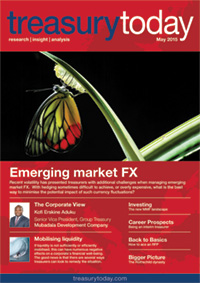Contents
- Editorial
- We will all pay for over-regulation
- Question Answered
- Question Answered: ME cash management
- Market View
- End of monetary easing approaches
- Insight & Analysis
- A volatile mix: EM currencies
- The Bigger Picture
- Nathan Rothschild: the mastermind behind the dynasty
- Special Feature: ING
- Innovation and digitisation: the treasurer’s imperative
- The Corporate View
- Corporate View: Kofi Erskine Aduku, Mubadala
- Cash Management
- Moving in waves
- Investing
- Getting to grips with VNAV
- Career Prospects
- A day in the life: interim treasury
- Regulation
- A double-edged sword
- Back to Basics
- How to ace an RFP
Editorial
We will all pay for over-regulation
You only have to talk to a banker these days and the increasing cost of regulation is the first or second topic of conversation. In fact, it is sometimes the first and the second topic of conversation.
You only have to peruse any of the banks’ recent results and the increasing cost of compliance is not only reported, but also the subject of specific comment. The banks cannot do much about this and one could say they brought it on themselves. But the level of regulation is now becoming overwhelming as each government introduces its own version of the rules. Banks operating in multiple jurisdictions find themselves facing different versions of the same kind of regulation, each with its own local variation.
You only have to go to an industry conference and the issues being discussed are the same. At the recent ICC Banking Commission Annual Meeting in Singapore, the discussion kicked off with commentary on how banks were exiting some areas of trade finance because of the increasing compliance and risk costs. New Basel ratios are requiring more capital for the banks’ trade business. Doing business with low risk-weighted multinationals is becoming more attractive than doing business with other more highly risk-rated companies.
You only have to start looking at the increased capital requirements being imposed on the banking groups and then wonder where the return on this increased capital is going to come from. Global systemically important banks, also referred to as ‘too big to fail’, face even higher capital requirements under the recently clarified TLAC (Total Loss Absorbency Capacity) requirements.
So far, so good. Safer banks taking less risk. But, there is another unfortunate side effect that is beginning to emerge. The regulation is encouraging banks to shrink their balance sheets to meet capital requirements. This may mean exiting or selling existing business streams or passing (selling) portfolios of risk to others, namely, other investors who do not have the same capital constraints, such as investment funds of various sorts. Sound familiar?
Yes it does, and the funds are not stupid. They are hesitant and seeking only the best portfolios of risk. So this encourages the banks to adopt business models that create, package and distribute large volumes of the best quality assets – loans and other facilities to the strongest corporate credits. Everyone else will start to have fewer financing options.
Meanwhile, new liquidity rules are making short-term deposits from customers much less attractive. Have you been offered 30 day deposits yet? One year deposits will be sought as we move towards 2018. So much for corporate liquidity requirements with money market funds also facing challenging regulation.
Even the most basic functions such as opening a bank account are being affected, as our recent webinar with the Singapore ACTS showed. Just establishing a new banking relationship is fraught with evolving requirements, as KYC (Know Your Customer) is becoming KYCC (Know Your Customer’s Customer) and AML (Anti Money Laundering) is becoming ML/TF (anti Money Laundering and Terrorist Financing). This is leading banks to exit their relationships with other banks, let alone their corporate customers.
Banks may be safer, but they are being over regulated and their ability to meet customers’ basic banking and financing requirements is being seriously hampered. We will all end up paying for this increased regulation.


